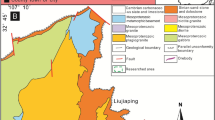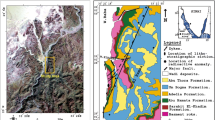Abstract
Submillimetre uraninite fragments are embedded in anthraxolite, oil-derived bitumen found in Permian rocks of the Vrchlabí formation (Czech Republic). The radiogenic system appears unaltered as indicated by the elemental and lead isotopic composition of uraninite. Low compositional variances in uraninite indicate protective properties of the bitumen envelope. The highly radiogenic composition of lead in uraninite allows dating by the SEM/EDX based chemical method, which confirms the Permian age of the mineralization. The studied association is considered to be a prospective natural analogue of long-term geological disposal of actinide-bearing bituminized radioactive waste.










Similar content being viewed by others
References
Ojovan MI, Lee WE (2005) Chapter 16—immobilisation of radioactive wastes in bitumen. In: Ojovan MI, Lee WE (eds) An introduction to nuclear waste immobilisation. Elsevier, Amsterdam, pp 201–212
Amter S (1989) Natural analogues. Eng Geol 26:431–440. https://doi.org/10.1016/0013-7952(89)90026-4
Pérez del Villar L, Bruno J, Campos R, Gómez P, Garralón CJS et al (2002) The uranium ore from Mina Fe (Salamanca, Spain) as a natural analogue of processes in a spent fuel repository. Chem Geol 190:395–415. https://doi.org/10.1016/S0009-2541(02)00127-4
Hellmuth KH (1989) Natural analogues of bitumen and bituminized radioactive waste (STUK-B-VALO 58). Finnish Centre for Radiation and Nuclear Safety, Helsinki. https://inis.iaea.org/collection/NCLCollectionStore/_Public/21/027/21027187.pdf
René M (2017) History of uranium mining in Central Europe. In: Awwad NS (ed) Uranium-safety, resources, separation and thermodynamic calculation. IntechOpen, London
Havelcová M, Sýkorová I, René M, Mizera J, Coubal M, Machovič V, Strunga V, Goliáš V (2022) Geology and petrography of uraniferous bitumens in Permo-Carboniferous sediments (Vrchlabí, Czech Republic). Minerals 12:544. https://doi.org/10.3390/min12050544
McEachern RJ, Taylor P (1998) A review of the oxidation of uranium dioxide at temperatures below 400 °C. J Nucl Mater 254:87–121. https://doi.org/10.1016/S0022-3115(97)00343-7
Janeczek J, Ewing RC (1992) Structural formula of uraninite. J Nucl Mater 190:128–132. https://doi.org/10.1016/0022-3115(92)90082-V
Fayek M, Burns P, Yong-Xiang G, Ewing RC (2000) Micro-structures associated with uraninite alteration. J Nucl Mater 277:204–210. https://doi.org/10.1016/S0022-3115(99)00199-3
Fayek M, Kyser TK, Riciputi LR (2002) U and Pb isotope analysis of uranium minerals by ion microprobe and the geochronology of the McArthur River and Sue Zone uranium deposits, Saskatchewan, Canada. Can Min 40:1553–1569. https://doi.org/10.2113/gscanmin.40.6.1553
Škácha P, Goliáš V, Sejkora J, Plášil J, Strnad L, Škoda R, Ježek J (2009) Hydrothermal uranium—base metal mineralization of the Jánská vein, Březové Hory, Příbram, Czech Republic: lead isotopes and chemical dating of uraninite. J Geosci 54:1–13. https://doi.org/10.3190/jgeosci.030
Parnell J (1993) Chemical age dating of hydrocarbon migration using uraniferous bitumens, Czech-Polish border region. In: Parnell J, Kucha H, Landais P (eds) Bitumens in ore deposits. Springer, Berlin, pp 510–517
Bowles JFW (1990) Age dating of individual grains of uraninite in rocks from electron microprobe analyses. Chem Geol 83:47–53. https://doi.org/10.1016/0009-2541(90)90139-X
Hurtado JM, Chatterjee N, Ramezani J, Hodges KV, Bowring SA (2007) Electron microprobe chemical dating of uraninite as a reconnaissance tool for leucogranite geochronology. Nat Prec. https://doi.org/10.1038/npre.2007.655.1
Čurda M (2014) Lead isotopes and 210Pb in recent galenas of the Lower Silesia basin. Diploma thesis, Faculty of Sciences, Charles University, Prague (in Czech). https://dspace.cuni.cz/bitstream/handle/20.500.11956/72250/120168037.pdf?sequence=1&isAllowed=y
Lin J, Liu Y, Yang Y, Hu Z (2016) Calibration and correction of LA-ICP-MS and LA-MC-ICP-MS analyses for element contents and isotopic ratios. Solid Earth Sci 1:5–2. https://doi.org/10.1016/j.sesci.2016.04.002
Holá M, Novotný K, Dobeš J, Krempl I, Wertich V, Mozola J, Kubeš M, Faltusová V, Leichmann J, Kanický V (2021) Dual imaging of uranium ore by Laser Ablation Inductively Coupled Plasma Mass Spectrometry and Laser Induced Breakdown Spectroscopy. Spectrochim Acta B 186:106312. https://doi.org/10.1016/j.sab.2021.106312
Oriolo S, Wemmer K, Oyhantçabal P, Fossen H, Schulz B, Siegesmund S (2018) Geochronology of shear zones—a review. Earth Sci Rev 185:665–683. https://doi.org/10.1016/j.earscirev.2018.07.007
Evins LZ, Jensen KA, Ewing RC (2005) Uraninite recrystallization and Pb loss in the Oklo and Bangombe natural fission reactors, Gabon. Geochim Cosmochim Acta 69:1589–1606. https://doi.org/10.1016/j.gca.2004.07.013
Machovič V, Havelcová M, Lapčák L, Mizera J, Sýkorová I (2022) Chemical character and structure of uraniferous bitumens (Vrchlabí, Czech Republic). Int J Coal Geol 264:104137. https://doi.org/10.1016/j.coal.2022.104137
Havelcová M, Machovič V, Mizera J, Sýkorová I, Borecká L, Kopecký L (2014) A multi-instrumental geochemical study of anomalous uranium enrichment in coal. J Environ Radioact 137:52–63. https://doi.org/10.1016/j.jenvrad.2014.06.015
Řanda Z, Frána J, Mizera J, Kučera J, Novák JK, Ulrych J, Belov AG, Maslov OD (2007) Instrumental neutron and photon activation analyses in geochemical study of phonolitic and trachytic rocks. Geostand Geoanal Res 31:275–283. https://doi.org/10.1016/0012-821X(75)90088-6
Mizera J, Řanda Z (2010) Instrumental neutron and photon activation analyses of selected geochemical reference materials. J Radioanal Nucl Chem 284:157–163. https://doi.org/10.1007/s10967-010-0447-2
Řanda Z, Ulrych J, Turek K, Mihaljevič M, Adamovič J, Mizera J (2010) Radiobarites from the Cenozoic volcanic region of the Bohemian Massif: radiochemical study, history, and lead isotopic composition. J Radioanal Nucl Chem 283:89–94. https://doi.org/10.1007/s10967-009-0095-6
Stacey JC, Krammers JD (1975) Approximation of terrestrial lead isotope evolution by two stage model. Earth Planet Sci Lett 26:207–221. https://doi.org/10.1016/0012-821X(75)90088-6
Acknowledgements
The study has been supported by the Czech Science Foundation (GAČR) project 19-05360S –“Radiolytic alteration of organic matter in uraniferous environment”. It has been performed within the open-access infrastructure CANAM funded by the Ministry of Education, Youth, and Sports of the Czech Republic within the project LM2015056. The SEM-EDX work has been realized within the Institutional Support from the Ministry of Industry and Trade of the Czech Republic.
Author information
Authors and Affiliations
Corresponding author
Ethics declarations
Conflict of interest
The authors have no relevant financial or non-financial interests that are relevant to the content of this article. The funding of this work is honestly disclosed in the acknowledgements section.
Additional information
Publisher's Note
Springer Nature remains neutral with regard to jurisdictional claims in published maps and institutional affiliations.
Rights and permissions
Springer Nature or its licensor (e.g. a society or other partner) holds exclusive rights to this article under a publishing agreement with the author(s) or other rightsholder(s); author self-archiving of the accepted manuscript version of this article is solely governed by the terms of such publishing agreement and applicable law.
About this article
Cite this article
Strunga, V., Sihelská, K., Lorinčík, J. et al. Natural bitumen hosted uranium mineralization: stability of the radiogenic system. J Radioanal Nucl Chem 332, 1597–1606 (2023). https://doi.org/10.1007/s10967-022-08692-5
Received:
Accepted:
Published:
Issue Date:
DOI: https://doi.org/10.1007/s10967-022-08692-5




